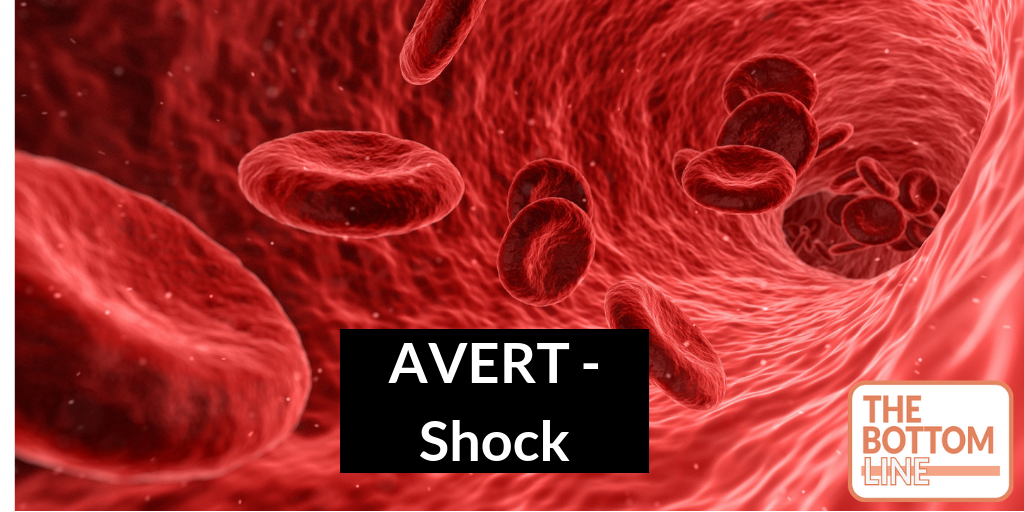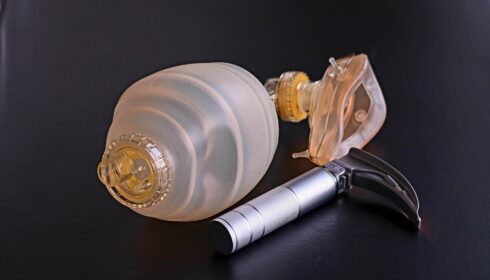AVERT Shock

Effect of Low-Dose Supplementation of Arginine Vasopressin on Need for Blood Product Transfusions in Patients with Trauma and Hemorrhagic Shock: A Randomized Clinical Trial (AVERT Shock)
Sims et al, JAMA Surgery, Published Online August 28, 2019, doi:10.1001/jamasurg.2019.2884
Clinical Question
- In trauma patients with hemorrhagic shock, does the use of low-dose arginine vasopressin compared to placebo reduce the volume of blood products transfused?
Background
- Traumatic hemorrhagic shock is a leading cause of death among adults under 45 years
- Traumatic hemorrhagic shock is associated with neuroendocrine dysfunction
- Arginine Vasopressin (AVP) deficiency underlies this neuroendocrine dysfunction. AVP deficiency in trauma occurs due to depletion of AVP stores, loss of AVP in haemorrhage, and resuscitation with AVP-deficient blood products
- Replacement of AVP can help with:
- Vasomotor tone
- Haemostasis from improvement in platelet function
- Vasoconstriction of injured vessels and shunting blood to vital organs
- Retrospective human studies have found increased mortality with AVP use in this population
Design
- Randomised controlled trial
- Computerized block randomization
- Blinding of clinical team, research personnel, patients & families
- Both intention-to-treat and per-protocol analyses performed
- Per-protocol excluded patients dying early in operating room, deemed as “nonsurvivable” injuries
- Registered on clinicaltrials.gov
- 100 patients required to give 80% power and a 2 sided alpha of 0.05 to detect a 50% reduction in total volume of blood products from a baseline mean use of 5.4L of blood products
Setting
- Single urban level 1 trauma centre, USA
- Data collected 2013 – 2017
Population
- Inclusion: Adult trauma patients receiving more than 6 units of any blood product within 12 hours of admission
- Exclusion: interhospital transfers, prehospital CPR, emergency department thoracotomy, recent corticosteroid use, chronic renal insufficiency, significant coronary artery disease, traumatic brain injury requiring neurosurgical intervention, pregnancy, incarcerated patients
- 257 patients identified, with 157 excluded predominantly for insufficient blood transfusion (< 6units), or ED thoracotomy being performed
- 101 randomized, with 1 post-randomization refusal
- Comparing baseline characteristics of intervention group (n=49 ) vs. placebo (n=51) no significant differences for:
- Patient demographics (age, sex, ethnicity) – only 7 women in total
- Injury and mechanism characteristics including admission vital signs, site of bleeding, enrolment vital signs, ISS Score
- Penetrating trauma: 80% vs. 78%
- Injury Severity Score: 19 (14-26) vs. 26 (17-34)
- Initial lab values (lactate, creatinine, hemoglobin, coagulation panel)
- Pre-enrolment resuscitation (crystalloids, blood components, tranexamic acid, EBL)
Intervention
- Arginine Vasopressin (AVP)
- 4U bolus of AVP following randomization
- 0.04U/min infusion (0.4U/mL concentration) started after bolus
- Titrated 0-0.04U/min following surgical control of bleeding to maintain MAP >= 65 for 48 hours
Control
- Placebo
- Bolus of normal saline in equivalent volume as AVP
- Infusion of saline placebo of equivalent volume
Management common to both groups
- 1:1:1 transfusion strategy in both groups was suggested (though not protocolized
- Crystalloid and blood products at discretion of treating physician
- Additional vasopressors at discretion of physician (phenylephrine, norepinephrine, epinephrine)
- These were titrated and stopped before tapering study infusion
- Study coordinator monitored all resuscitations to ensure compliance in protocol
Outcome
- Primary outcome: AVP vs. placebo
- Cumulative volume of blood products transfused within 48hrs (including red blood cells, fresh frozen plasma & platelets) – significantly reduced in AVP group
- 1.7 (0.7-3.1) vs 3.0 (1.4-5.2)
- Median Difference: -1.00L (-2.03 to 0.00L, P = 0.03)
- For each component of primary outcome
- No significant difference in:
- PRBC, median (IQR) in L
- 0.9 (0.1-1.8) vs 1.0 (0.6-3.0) P = 0.08
- PRBC, median (IQR) in L
- In AVP group significantly reduced:
- FFP, median (IQR) in L
- 0.9 (0.8-1.3) vs 1.0 (0.5-1.8) P = 0.03
- Platelets, median (IQR) in mL
- 200 (0-300) vs 300 (0-600) P = 0.02
- Cryoprecipitate, mean (SD) in mL
- 12.6 (75.4) vs 34.7 (84.8) P = 0.04
- FFP, median (IQR) in L
- No significant difference in:
- Cumulative volume of blood products transfused within 48hrs (including red blood cells, fresh frozen plasma & platelets) – significantly reduced in AVP group
- Secondary outcome:
- No difference in any of the secondary outcomes studied:
- Volume of crystalloid transfused in 48hr
- 9.6 vs. 10l
- Fluid balance in 48hr
- 6l vs. 7l
- Total vasopressor requirements for 48hr
- 30 day mortality
- 12% vs. 12%
- Hospital/ICU length of stay
- Organ dysfunction (AKI, ARDS, open abdomen free days, ventilator free days)
- Volume of crystalloid transfused in 48hr
- No difference in adverse events except:
- DVT – significantly reduced in AVP group
- 20% vs. 39%, P=0.05
- RR (95% CI): 0.33 (0.13-0.83) p = 0.02
- DVT – significantly reduced in AVP group
- No difference in any of the secondary outcomes studied:
Authors’ Conclusions
- Early administration of AVP during the resuscitation of trauma patients with hemorrhagic shock leads to decreased use of blood products at 48hours without increased complications
Strengths
- Randomized control trial with appropriate blinding
- Balanced pragmatic design vs. protocolized design allow modest generalizability
- Intention-to-treat and per-protocol analysis allowing for standardization of patients with non-survivable injuries
- Physiologic basis for the findings are well supported
- Registered on clinicaltrials.gov
Weaknesses
- Single center trial limits generalizability, open to institutional practice bias
- Study population predominantly young males with penetrating trauma, limiting generalizability
- Not adequately powered for secondary endpoints, or safety markers
- Sample size calculation based on baseline volume of blood products of 5.4l where as actual baseline was only 3l
The Bottom Line
- Trauma patients presenting with hemorrhagic shock may benefit from low-dose vasopressin supplementation to prevent blood transfusion, however larger multicentre trials are needed to determine efficacy & safety of this practice. The findings of this study do not suggest changes in practice at this time
External Links
- [article] Effect of Low-Dose Supplementation of Arginine Vasopressinon Need for Blood Product Transfusions in Patients With Trauma and Hemorrhagic Shock A Randomized Clinical Trial
- [further reading] Invited commentary: Vasopressin as an Early Adjunct to Resuscitation in Hemorrhagic Shock: Crisis AVERTed?
Metadata
Summary author: Vatsal Trivedi
Summary date: 01/09/2019
Peer-review editor: David Slessor




Does the result of this study sound meaningful? How can a vasoconstrictor agent reduce the volume of transfusion? Is it only the enhancement of exocytosis of vWf from vasopressin that made the difference?